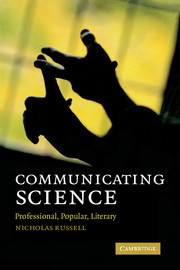Book contents
- Frontmatter
- Contents
- Introduction: What this book is about and why you might want to read it
- Prologue: Three orphans share a common paternity: professional science communication, popular journalism and literary fiction are not as separate as they seem
- Part I Professional science communication
- Part II Science for the public: what science do people need and how might they get it?
- Part III Popular science communication: the press and broadcasting
- Part IV The origins of science in cultural context: five historic dramas
- Part V Science in literature
- 20 Science and the Gothic: the three big nineteenth-century monster stories
- 21 Science fiction: serious literature or low grade entertainment?
- 22 Science in British literary fiction
- 23 Science on stage: the politics and ethics of science in cultural and educational contexts
- Index
- References
21 - Science fiction: serious literature or low grade entertainment?
Published online by Cambridge University Press: 02 December 2010
- Frontmatter
- Contents
- Introduction: What this book is about and why you might want to read it
- Prologue: Three orphans share a common paternity: professional science communication, popular journalism and literary fiction are not as separate as they seem
- Part I Professional science communication
- Part II Science for the public: what science do people need and how might they get it?
- Part III Popular science communication: the press and broadcasting
- Part IV The origins of science in cultural context: five historic dramas
- Part V Science in literature
- 20 Science and the Gothic: the three big nineteenth-century monster stories
- 21 Science fiction: serious literature or low grade entertainment?
- 22 Science in British literary fiction
- 23 Science on stage: the politics and ethics of science in cultural and educational contexts
- Index
- References
Summary
“Joanna how can you read that stuff? Garish covers, cheap production values, it's all so repetitive. Science fiction looks clever to an adolescent, especially when you start to learn science. I used to read it myself, but when you grow up, it all seems pretty immature!”
“David, you've used the right word; garish. The covers are brazen and they're saying ‘pick me up! Read me! Don't be afraid! Here are adventures!’ ”
“Exactly, they're just thrillers set in deep space or time. There are no real characters; they don't face any moral challenges.”
“That's so patronizing.” Joanna chucked her rather dog-eared paperback at him but missed. “Conventional literary stuff is not the point. Science fiction is about ideas, what will happen if certain technological breakthroughs occur, if different political or philosophical ideas are played out? All these future scenarios warn us about what might happen.”
“Oh yeah, well most of them seem to rely on scientists being put in charge and monkeying about with what it means to be human to make us susceptible to control. I don't much like solutions to our troubles that depend on having Strangeloves in charge with robots and ray guns. Proper literature teaches us about the human condition, solving human problems needs humanity not science.”
“OK.” Joanna suddenly grinned. “Is Doris Lessing a proper literary figure?”
“Silly question.” From David, “of course she is, she won the Nobel Prize for Literature.” […]
- Type
- Chapter
- Information
- Communicating ScienceProfessional, Popular, Literary, pp. 262 - 282Publisher: Cambridge University PressPrint publication year: 2009



